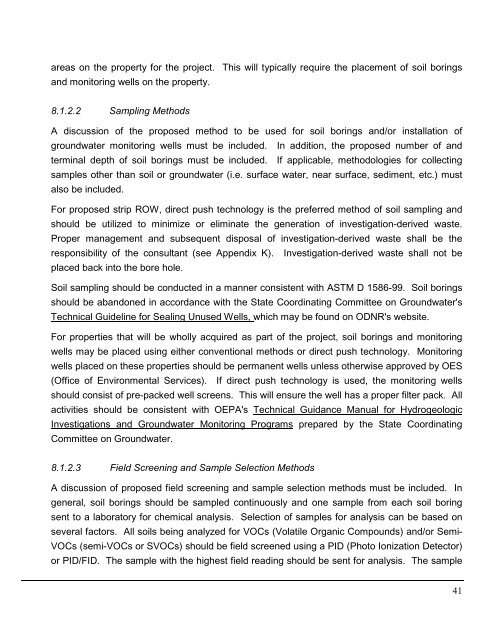Environmental Site Assessment Guidelines - Ohio Department of ...
Environmental Site Assessment Guidelines - Ohio Department of ...
Environmental Site Assessment Guidelines - Ohio Department of ...
You also want an ePaper? Increase the reach of your titles
YUMPU automatically turns print PDFs into web optimized ePapers that Google loves.
areas on the property for the project. This will typically require the placement <strong>of</strong> soil borings<br />
and monitoring wells on the property.<br />
8.1.2.2 Sampling Methods<br />
A discussion <strong>of</strong> the proposed method to be used for soil borings and/or installation <strong>of</strong><br />
groundwater monitoring wells must be included. In addition, the proposed number <strong>of</strong> and<br />
terminal depth <strong>of</strong> soil borings must be included. If applicable, methodologies for collecting<br />
samples other than soil or groundwater (i.e. surface water, near surface, sediment, etc.) must<br />
also be included.<br />
For proposed strip ROW, direct push technology is the preferred method <strong>of</strong> soil sampling and<br />
should be utilized to minimize or eliminate the generation <strong>of</strong> investigation-derived waste.<br />
Proper management and subsequent disposal <strong>of</strong> investigation-derived waste shall be the<br />
responsibility <strong>of</strong> the consultant (see Appendix K). Investigation-derived waste shall not be<br />
placed back into the bore hole.<br />
Soil sampling should be conducted in a manner consistent with ASTM D 1586-99. Soil borings<br />
should be abandoned in accordance with the State Coordinating Committee on Groundwater's<br />
Technical Guideline for Sealing Unused Wells, which may be found on ODNR's website.<br />
For properties that will be wholly acquired as part <strong>of</strong> the project, soil borings and monitoring<br />
wells may be placed using either conventional methods or direct push technology. Monitoring<br />
wells placed on these properties should be permanent wells unless otherwise approved by OES<br />
(Office <strong>of</strong> <strong>Environmental</strong> Services). If direct push technology is used, the monitoring wells<br />
should consist <strong>of</strong> pre-packed well screens. This will ensure the well has a proper filter pack. All<br />
activities should be consistent with OEPA's Technical Guidance Manual for Hydrogeologic<br />
Investigations and Groundwater Monitoring Programs prepared by the State Coordinating<br />
Committee on Groundwater.<br />
8.1.2.3 Field Screening and Sample Selection Methods<br />
A discussion <strong>of</strong> proposed field screening and sample selection methods must be included. In<br />
general, soil borings should be sampled continuously and one sample from each soil boring<br />
sent to a laboratory for chemical analysis. Selection <strong>of</strong> samples for analysis can be based on<br />
several factors. All soils being analyzed for VOCs (Volatile Organic Compounds) and/or Semi-<br />
VOCs (semi-VOCs or SVOCs) should be field screened using a PID (Photo Ionization Detector)<br />
or PID/FID. The sample with the highest field reading should be sent for analysis. The sample<br />
41

















